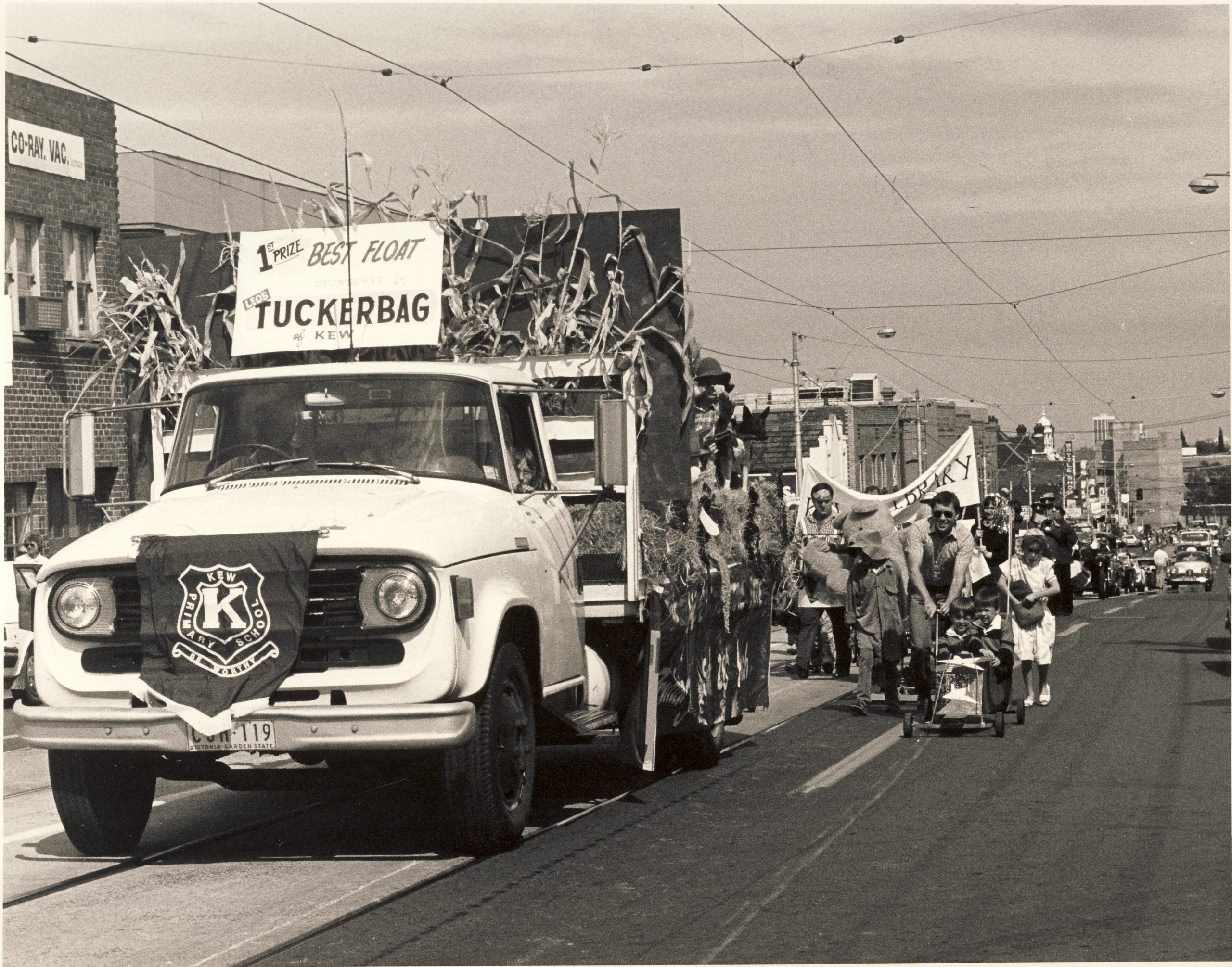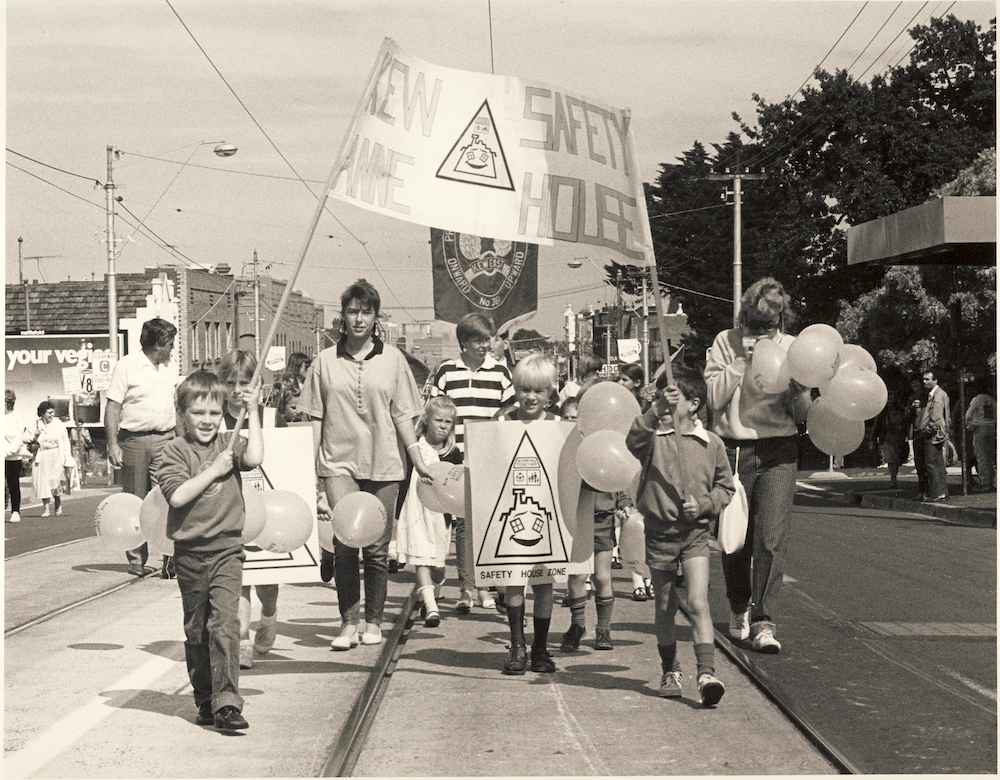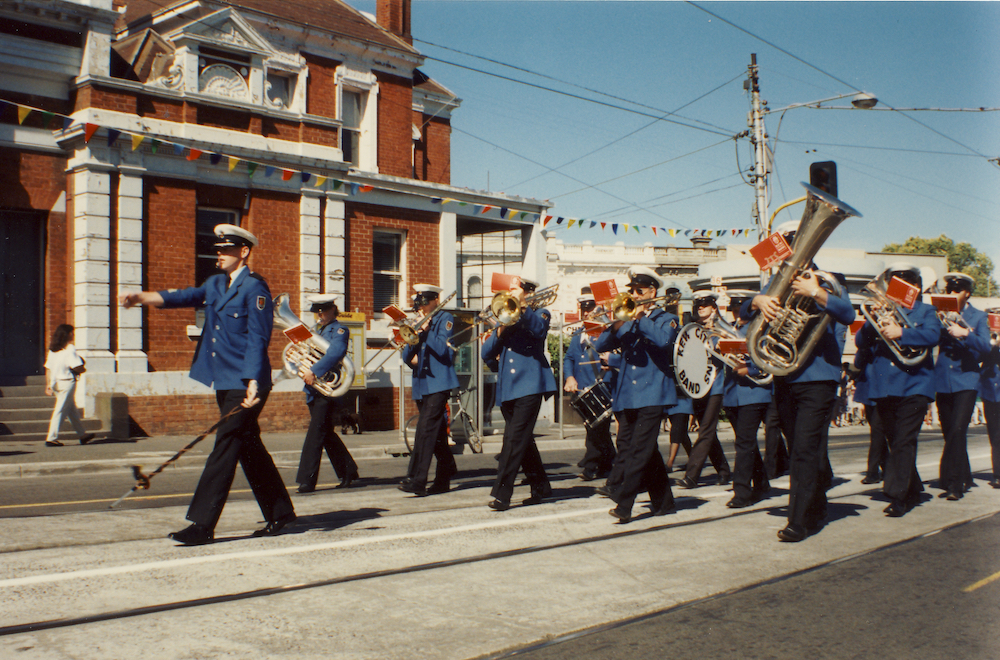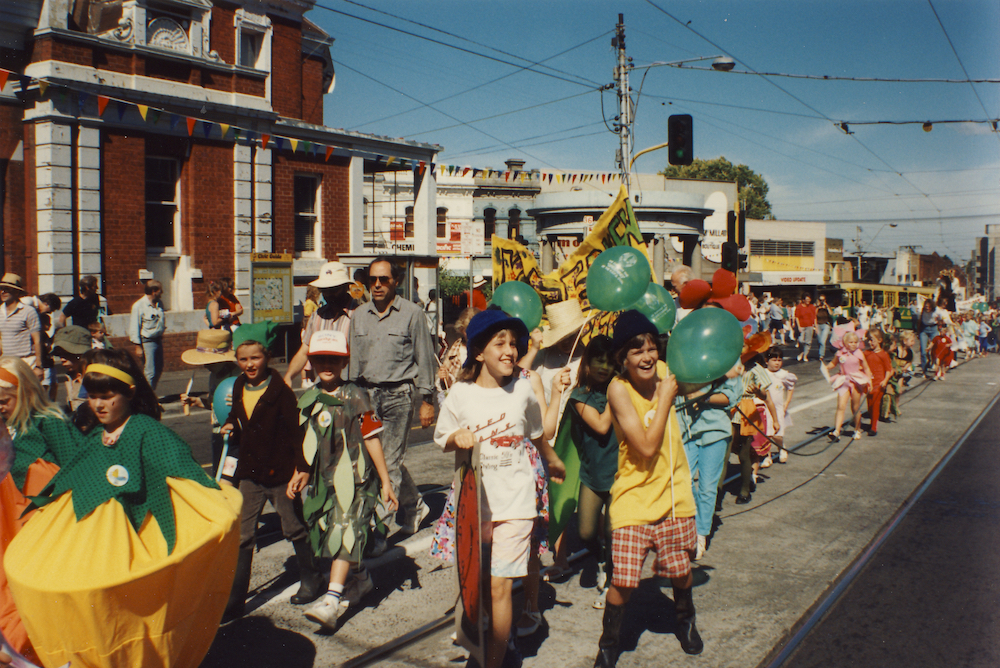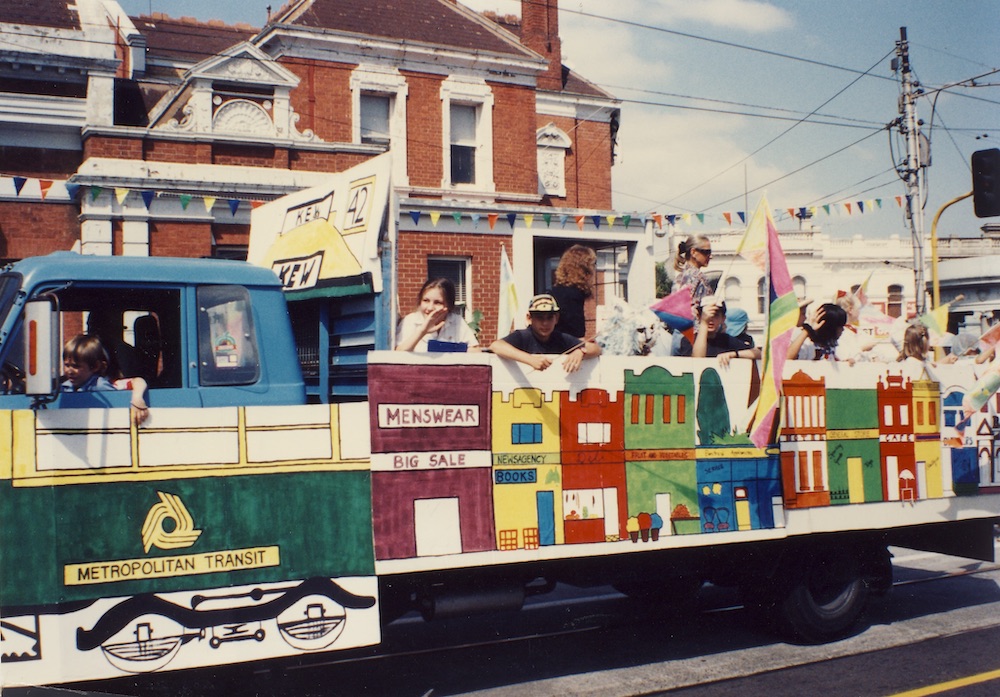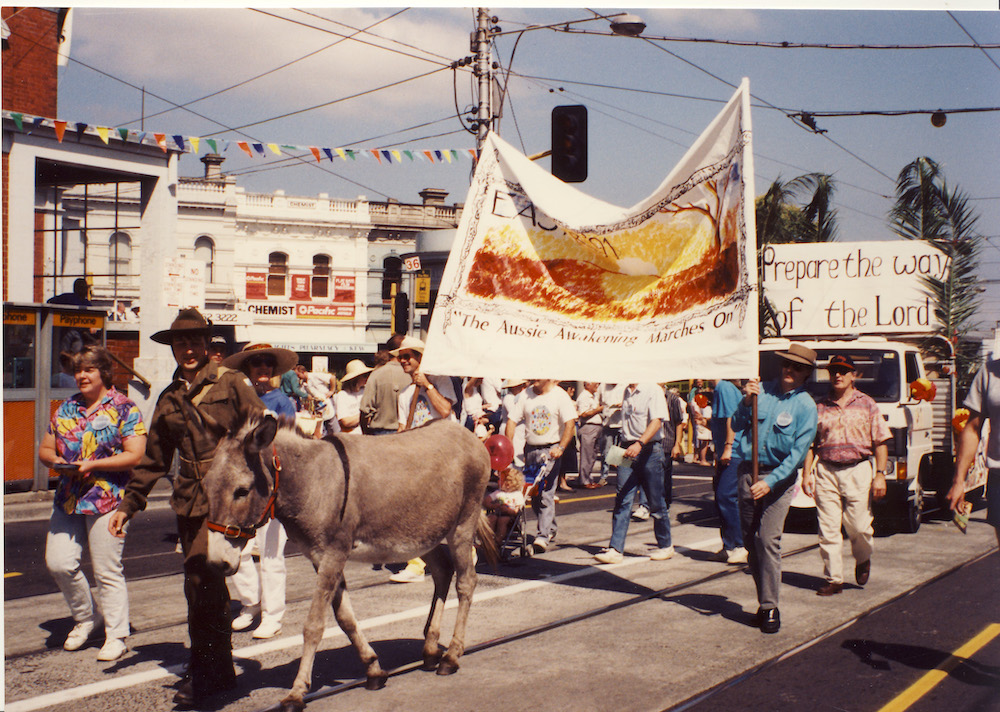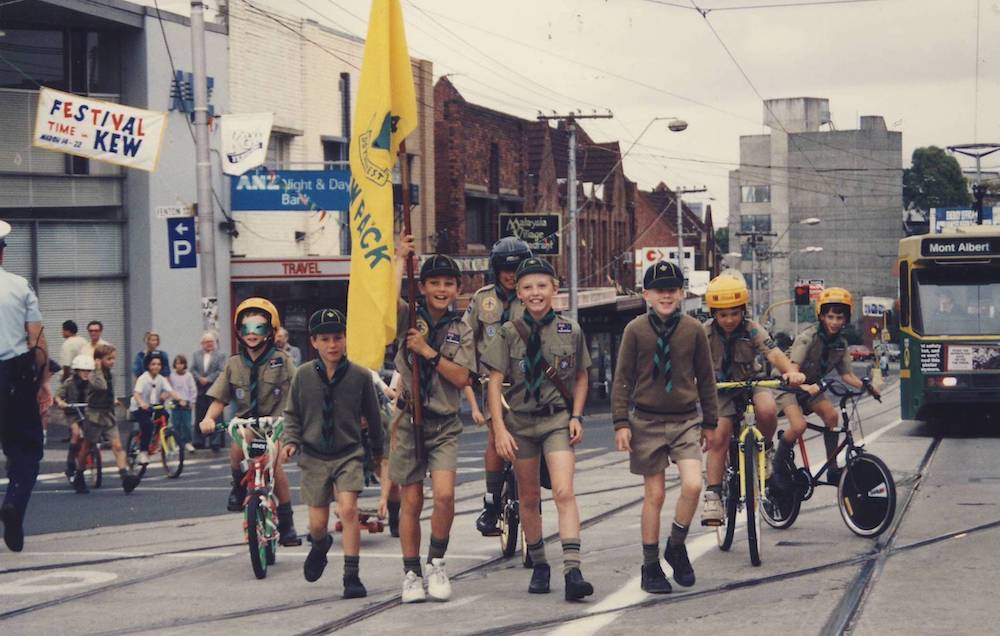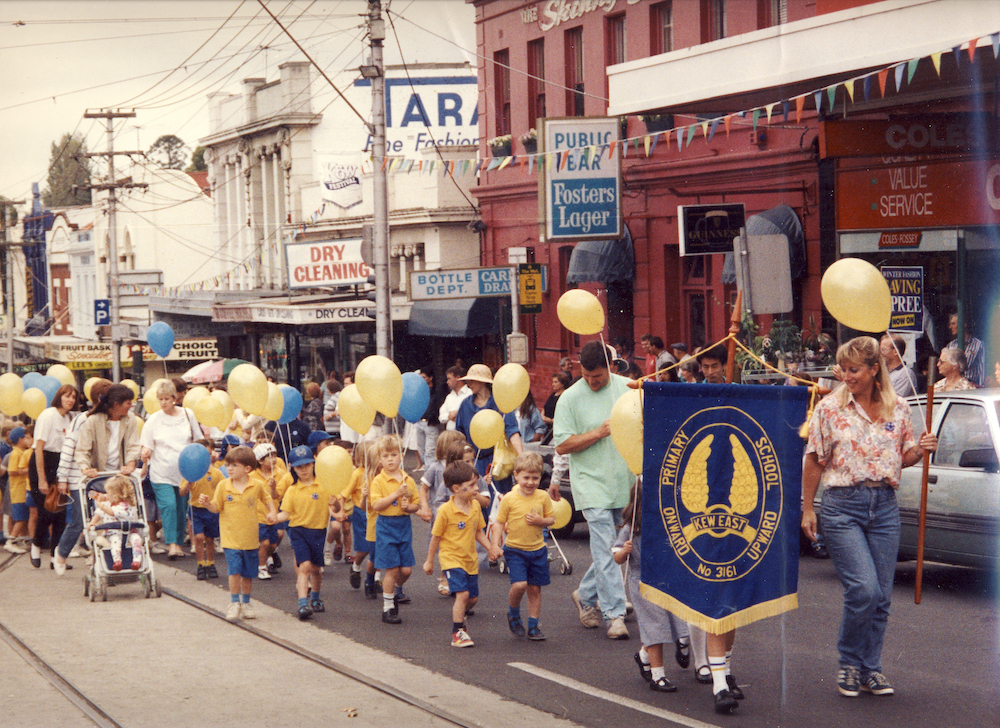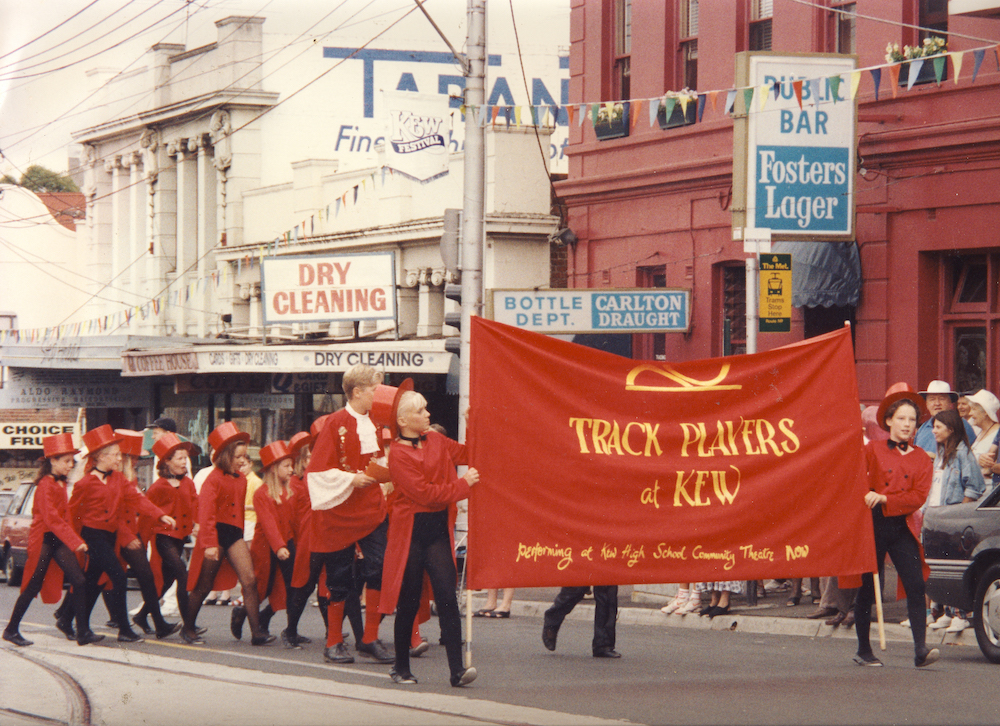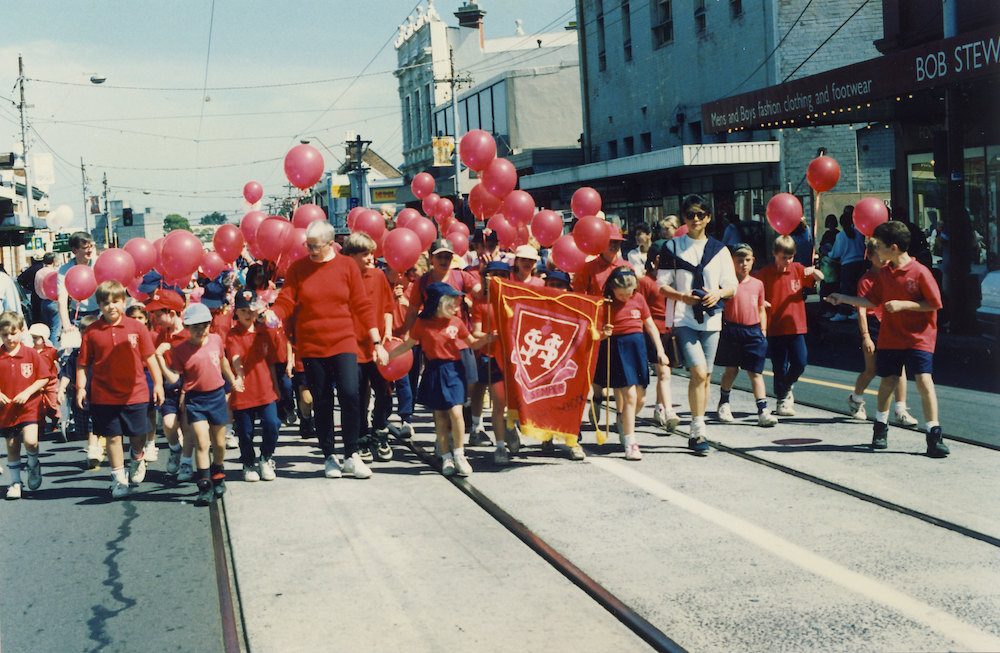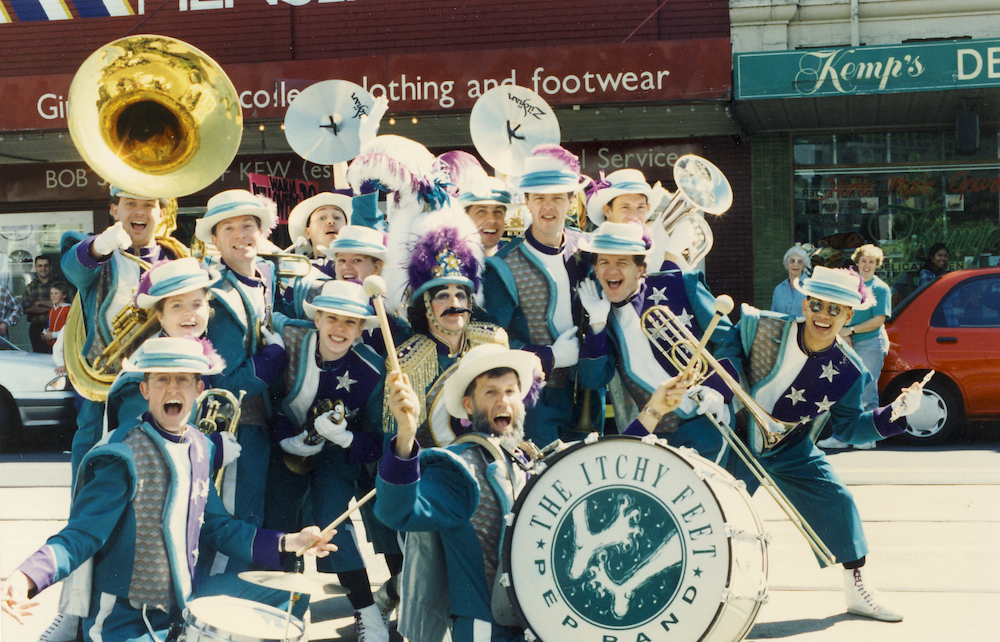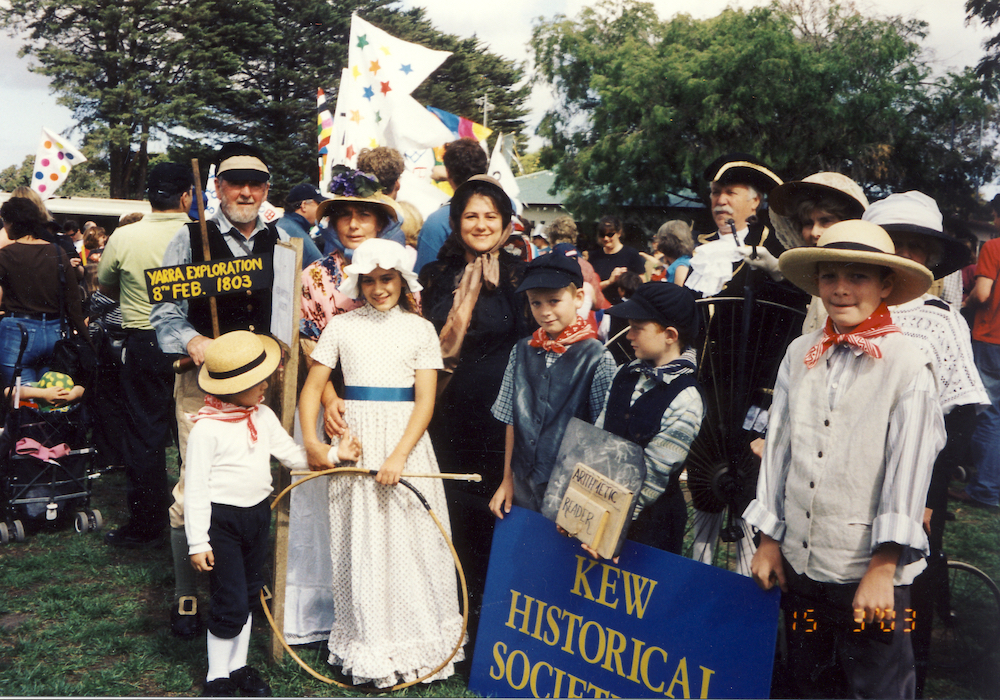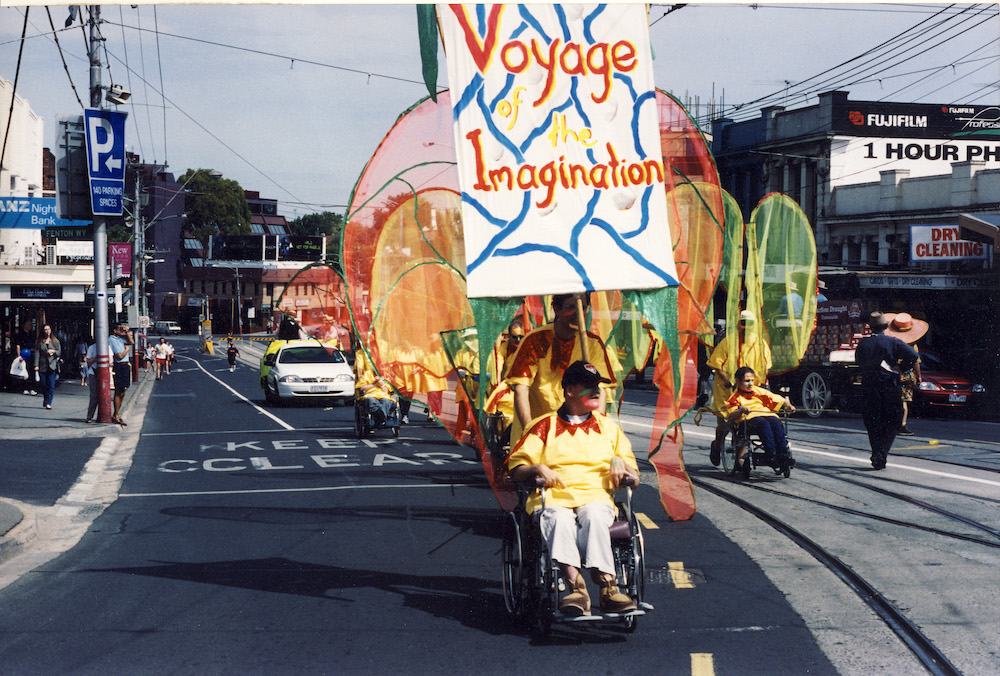ON PARADE – THE KEW FESTIVAL
Kew Court House
March 2020 – June 2020
Curators – Judith Scurfield, Robert Baker
Parades were traditionally designed to allow community groups to participate in local festivals. The Kew Festival, initiated in 1974, encouraged community groups to engage with and value local heritage. As part of the 2020 Kew Festival and the 2020 Australian Heritage Festival, an exhibition of photographs of previous festival parades enables you to view and perhaps identify members of those groups. Each picture is followed by a caption explaining its significance.
Exhibition images and captions
BEST FLOAT IN SHOW
c.1990
Parades were often a showcase for local traders as well as for schools, churches, cultural groups and clubs. Sometimes they sponsored decorated floats, such as this truck, probably supported by Leo’s Tuckerbag supermarket on behalf of Kew Primary School. And it won 1st Prize in the competition! Behind it come children and their families dressed as story-book characters, representing Kew Library. They are followed by a cavalcade of Veteran and Classic cars. Tuckerbag supermarkets were an Australian retail staple from the 1970s to 1999, when they were swallowed up by a larger supermarket chain. The Kew shop seems to have been taken over in about 1982 by Leo Blake, who had started his family business selling fine food and wine in Seaford in 1971.
SAFETY HOUSE
c.1990
The ‘Safety House’ program began in Victoria in 1979, before being taken up by several other states. Its yellow squares with the Safety House logo seen in this photograph were placed on houses and businesses selected as safe places for children while in transit to and from school. Changing needs and practices saw the demise of the volunteer organisation in 2013, and its merger with Neighbourhood Watch. St Anne’s Catholic Primary School may have had an active Safety House program in the early 1990s. The school had been founded by the Josephite Sisters in 1931, sharing its site in Beresford Street, East Kew with the parish church. It continues as a small and caring school with a commitment to ‘working together in knowledge and faith’.
KEW CITIZENS BAND
c.1990
The Kew Citizens Band is a proud representative of the musical, theatrical and dance organisations that have participated in Kew Festival parades. It has possibly the longest continuous history of any such group, having been founded in 1925. It has taken part in many Eisteddfods, National and State Championships, and has been an A-Grade band since 1974. Now known as Kew Band Melbourne, it continues to perform at a range of concerts, community and corporate events. The Kew Post Office, Court House and Police Station previously occupied the complex of public buildings at the junction of Cotham Road and High Street from 1888. The former Post Office is now a restaurant, the Police Station houses a number of community groups while the Court House is a performance space.
HAPPY TO BE ON PARADE
c.1990
Children have always formed a large part of the Kew Festival, and street parades in particular. Here a group of cheerful children carry balloons up High Street past the War Memorial and Kew Post Office. The partly hidden banner, the green balloons and the costumes representing flowers and leaves suggest that the year had a ‘green’ or environmental theme. Were you or anyone you know in these photographs? Or, do you know in what year the photo was taken? Thank you, and enjoy the Festival, past and present!
HERE COMES A No 42 TRAM!
1991
Decorated floats, peopled with community members dressed in colourful costumes, were a feature of Kew Festival parades from the 1970s to the 1990s. This may have been in imitation of the much larger Moomba Parade in central Melbourne, which was held the weekend before the Kew Festival. Some floats were even re-used from the Moomba Parade, and sometimes the magnificent Clydesdale horses pulling a brewery waggon from Carlton & United Brewery found their way as far as Kew. Here a truck masquerades as a Number 42 Metropolitan Transit tram, which ran from the city to Mont Albert, along Cotham Road. It is now the Number 109 tram terminating at Box Hill. This float, filled with waving children, probably including Scouts, is beautifully decorated to represent shops along High Street and Cotham Road.
PREPARE THE WAY OF THE LORD
c.1991
Churches often marched in Kew Festival parades, frequently with elaborate banners and floats. Led by a donkey accompanied by a man in a First World War uniform, and with a group holding a banner aloft proclaiming the ‘Aussie Awakening Marches On’, the vanguard is followed by a truck, lined with palm fronds, emphasising the Easter message. Painted banners were a feature of many Australian parades in the nineteenth and twentieth centuries. Some early painted examples have been declared to be of cultural significance to the State of Victoria. No hand-painted banners used in previous Kew Festival parades are known to exist.
LIONESSES, SAINTS AND SCOUTS
1991
Festival participants here parade up High Street: Kew Lioness Club, Holy Trinity Church, and Scouts. The Kew Lioness Club was the first in Melbourne, starting in 1979 and continuing until 1992. The Club later donated to Kew Historical Society a number of its albums and records including a short history, Where violets once grew by Helen Joyce. In this photograph, members Prue Molnar, Shirley Gates, and Debbie McColl-Davis with her son Hugh, pass the end of Walpole Street. They are followed by parishioners from Holy Trinity Church, carrying a banner celebrating 125 years of that congregation, their church being founded in 1862. Behind them come members of a Kew Scout troop.
CFBB FIRE TRUCK
1992
Former Country Fire Brigade Board fire engines were popular visitors to community festivals, fetes, kindergartens, children’s events and parades. Here a fire truck with children and parents aboard rolls up High Street at the 1992 Kew Festival. It is passing the Coles Supermarket and Anthony’s Classics men’s fashion and formal wear shop. Most prominent is the pharmacy of Brenda Johnson, who was the last in a long line of pharmacists to occupy this site at 167 High Street. It was established there by FGA Barnard in 1886, and later owned by pharmacists Paton, Serpell, Dixon, Malone, Fry, Matson and Brenda Johnson. Brenda and her husband Bob donated a significant collection of pharmaceutical records, books and jars to the Kew Historical Society in 2019.
4TH KEW CUB PACK
c.1992
Members of the 4th Kew Cub Pack parade on foot and on bikes up High Street approaching the intersection of High Street and Cotham Road in front of a 109 Mont Albert Tram. The 4th Kew Scouts commenced in 1925, meeting at St Paul’s Anglican Church in East Kew. Kew Council leased the group land in Harrison Reserve, East Kew, where they erected a Scout Hall, which remains their home to this day. The group was very strong in the 1930s and 1940s and again in the 1970s and 1980s when, for a number of years, scout camps were held every month. The group currently consists of a Cub Pack, Scout Troop and Venturer Unit.
ONWARD AND UPWARD
1992
Kew East Primary School students in their characteristic school uniform march behind their teacher and their winged banner. Kew East Primary School was originally located between High Street (then Bulleen Road) and Kilby Road adjacent to Burke Road and was officially opened on 25 April 1892. With more people moving into the district, the School moved in 1905 to Strathalbyn Street. 1929 saw the erection of the brick Infant School adjacent to the main building. At one time it was called Kew East Central School and included years 7 & 8. When Kew High School started, the high school students were accommodated there while their own buildings were being completed.
TRACK PLAYERS
c.1992
The Track Players march in red top hats and tails in front of an enthusiastic crowd lining High Street. The red of their uniforms complements the ruddy façade of the Greyhound Hotel (later the Skinny Dog Hotel). The banner that they carry aloft advertises that they are performing at Kew High School Community Theatre Now! After the loss, due to demolition in 1960, of the Recreation Hall in Wellington Street and the Kew Civic Hall after it was converted into a Municipal Library in 1987, the ‘Renaissance Theatre’, as it was later renamed, became the main performing arts venue in the area. Kew High School was established in 1963 while its community theatre was built at a later date.
SACRED HEART PRIMARY SCHOOL
1994
Sacred Heart students in their red and blue uniforms hold aloft red balloons and a school banner as they march up High Street. By 1994, the school’s history had stretched back 105 years to when it was founded in 1889 by the FCJ Sisters in a building in Walpole Street. Ten years later, the present site in Cotham Road was acquired for a church, presbytery and school. The foundation stone was laid in 1900, and the following year the school moved from Walpole Street. The present church was opened in 1921 by Archbishop Mannix. In 1931 new classrooms were added to the original hall, which had been used for the church and school. More classrooms were added in 1974.
ITCHY FEET
1994
Musicians of the Itchy Feet Pep Band pose for a group photograph in front of Bob Stewart Menswear and Kemp’s Delicatessen.The first Bob Stewart founded his menswear shop in High Street in 1925. His grandsons, Robert and Francis operate the business now. The business frequently entered floats in Kew Festival Parades. Itchy Feet was one of a number of bands that participated in successive parades. Most of the musicians who marched in the parades later performed in the Alexandra Gardens and later at Victoria Park. The first grandstand in the Alexandra Gardens was erected to commemorate Kew’s Jubilee in 1910. The present grandstand was erected in 1988 during the Australian Bicentennial celebrations.
KEW HISTORICAL SOCIETY
2003
Members and friends of the Kew Historical Society pose for a group photo before heading off to join the festival parade. The Society participated in the first Kew Festival in 1974. Participation in successive festivals typically included displays at the Kew Library and parading wearing historical costumes. At left, Graeme Lindsay wears the costume of an explorer on the Charles Grimes expedition up the Yarra in 1803. Philip Slobom at the rear wears the Town Crier outfit that he wore during the campaign to save the Kew Court House, as well as in a number of parades.
KEW PRIMARY SCHOOL
c.2003
Preparing for each parade took weeks of planning as can be seen in this large group of marchers waiting outside Kew Primary School. Children of many year levels stand with teachers and parents in front of portable classrooms in the school yard. Many students carry flags or wear clothes proclaiming proudly their diversity and their heritage. The year 2020 is a special year for Kew State School as it commemorates 150 years as an educational institution. In 1870, when the school was founded, the ethnic diversity celebrated by this group of school children was unimagined.
VOYAGE OF THE IMAGINATION
c.2003
Following the tram tracks into Cotham Road at the Kew War Memorial, a group of young people with a disability from the Children’s Cottages Kew surround a colourful banner proclaiming Voyage of the Imagination. Enhancing this theme, huge coloured gossamer wings were attached to many of the wheelchairs. Parades in Australia have often included a number of professionally designed and prepared floats as well as those designed and created by amateurs and local groups. This trend was perhaps accentuated by the participation of marchers and floats from the Moomba Parade. In this picture, and the companion photograph of Studley Park Kindergarten, amateur and professionally designed banners and costumes harmoniously meld into a colourful display.
STUDLEY PARK KINDERGARTEN
2003
Participants in parades often included school children and less frequently those of kindergarten age. Here a group of revellers meet at a staging point before preparing to join the parade. There were a number of early kindergartens in Kew including those in Strathalbyn Street (1925), Peel Street (1928), and Denmark Street (1939). Each is believed to have been designed by Rowland Chipperfield, the City of Kew Building Services Chief. The Studley Park Kindergarten in Stawell Street was opened by the Minister of Health in 1957. Land for the Kindergarten was originally owned by Mrs Lucille Dunlop, widow of Davis Cup player Alfred Dunlop who lived at 9 Studley Avenue and after whom Dunlop Avenue was named.
KEW HIGH SCHOOL AND VETERAN CAR
c.2010
Veteran, vintage and classic cars have long been attractions at community festivals. Here a 1910 Delage, driven about 100 years later by Neil Ferguson and his wife Betty, takes part in the Festival. Parked in Pakington Street, it gathered a crowd of admirers, presumably including the group of students from Kew High School. Kew High School grew from the former Kew Central School in Kitchener Street, which had catered for the first eight years of schooling. The post war baby-boom and increased immigration created a need for more schools. In the decade from 1960, thirty new high schools opened in Victoria. Kew High opened in 1963 near the corner of Burke Road and High Street. It remains a thriving local institution with about 1,000 students, who are encouraged to live up to its motto: ‘Aspire, Strive, Achieve’.
